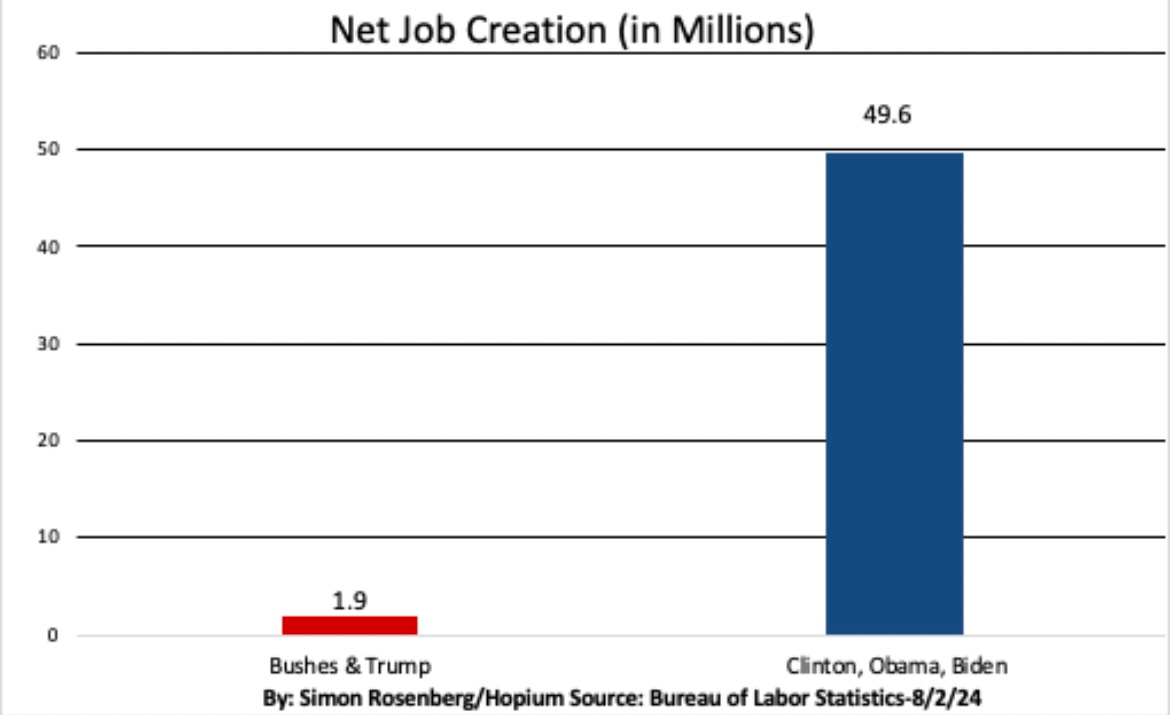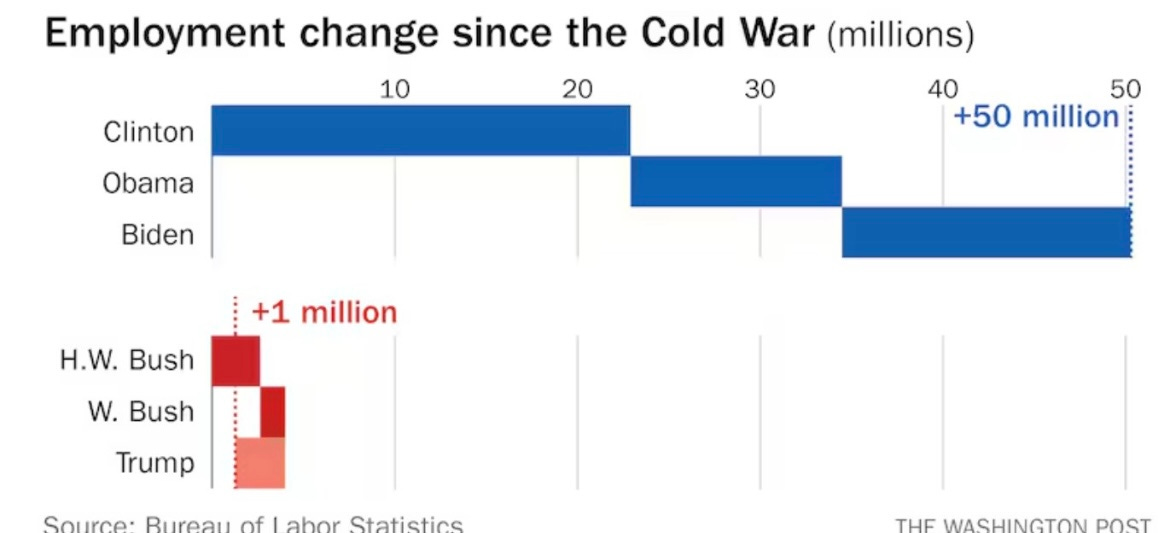Day 6–December 6, 2024
The American economy in November exceeded expectations, gaining 227,000 jobs, including 26,000 manufacturing jobs. Wages also grew by .4% in November, stronger than expected—lifting the annual increase to 4%.
With only two months to go in the Biden administration, November’s numbers take the total number of jobs under Biden (since January 2021) to more than 16 million, and extending an impressive streak: a net positive of jobs created every month of his tenure. In that time, the nation has also seen the lowest average unemployment of any administration in 50 years.
I share these numbers for several reasons.
First, remember them. They will be a valuable point of comparison to what happens once Trump takes over and imposes another round of billionaire-inspired trickle-down policies—which never work for anyone but those at the top. Last time, of course, he had already squandered the strong economy he inherited by 2019. Ohio and other states lost jobs between January 2019 and January 2020 (including manufacturing jobs), the first time that happened since the Great Recession and reversing the long period of Obama job growth. (Things only got worse amid Trump’s disastrous mismanagement of COVID.)
Second, let these job growth numbers challenge you—and all of us—because they also underscore one other reality:
The failure to translate consistent and robust job growth into political traction is a crisis Democrats desperately need to confront, study and correct. After all, it’s Democratic administrations where almost all the jobs are created. (As Clinton reminded us at the convention, it’s 50 million to 1 million).
But amid this dramatic contrast in jobs growth, Americans: 1) still generally give more credit to Republicans and Democrats on how they handle the economy; 2) told pollsters in the middle of 2024 that they believed the country was in a recession (here’s one poll from May, where that number stood at 56%); and 3) voted for the guy and policies that lost jobs as opposed to the people that sparked four years of job growth.
If that’s not a crisis, I don’t know what is.
Needless to say, there are several things going on here.
First, economics.
Clearly, how people rate the economy goes beyond job growth and GDP.
Wages, inflation, stability, broader income inequality, health care, debt, unaffordable housing, and other elements all factor in as well. If Americans don’t feel secure economically amid years of steady job growth, that itself is a problem crying out to be addressed. And the challenge presented to Democrats—and all policy makers—is to find and implement policies and create circumstances such that Americans feel more economically secure amid even low unemployment.
Second, politics.
Still, there’s a major political problem as well.
Just look at this graph summing up the facts in a different way:
And to be clear: beyond not creating jobs in all these decades, Republican policies have also not added to economic security in the other ways I list above. In most aspects, their policies (whether attacking unions, or wages, or health care, spending cuts, etc.) have taken things in the wrong direction. That may be a major reason that when Trump left the White House, he did so with an approval/disapproval rating of 34/61, “the lowest on record dating back since scientific polling began.”
But despite all that reality, Biden/Harris lose. And they lose amid exit polls finding that “[t]wo thirds of voters described the economy as bad, and those voters who did went big for Trump.”
And that, my friends, is a political problem. A five-alarm fire of a political problem.
It poses the basic question: How do you have four straight years of monthly job growth, record low unemployment, versus an administration that lost jobs, and ended as the most disapproved administration on record…and lose….on the very issue where you performed so markedly better.
Until we answer that question, we will struggle.
A Few Thoughts
In a post-mortem session at Harvard this week, top Democratic campaign leaders described the campaign they ran as “flawless,”
Rather than a flawed campaign, they instead attributed the loss to a broader negative mood in the electorate that was too tough to overcome: “So much more of this is about how people felt, regardless of what the numbers said, about the economy…And there’s just a general negative, clearly, feeling of where the direction of the country was.”
But, to be blunt, that “negative feeling” is not the unfixable problem to lament as the reason for an inevitable loss—it is the problem political leaders are tasked with overcoming. Solving it is the entire point.
Which takes us, again, to the underlying question, stated slightly differently: How, politically, did an Administration that had such strong indices of progress versus its opponent allow that “negative feeling” to set in about the country and its direction, and then calcify?
What was not done in four years such that that became the underlying, unshakeable (in their estimation) dynamic of this year’s race?
Isn’t that, in the end, the fundamental flaw of “the campaign?”
And rather than a separate, late-2024 effort, shouldn’t we see the “campaign” as the entire four-year effort to translate those positive results (and acknowledged remaining challenges) into a less “negative” feeling in the country in the first place? While also creating a stark contrast to the truly negative results of the Trump term that preceded it?
Think about FDR’s fireside chats. He did those as president, throughout. Read his States of the Union and other speeches as president—he touted all that he was doing, and lambasted the vision and policies of his opponents. And all these “off-year” communications were more important than any campaign tactic that emerged in the campaign years themselves. They created the backdrop of the campaigns itself. They established the sense of unity and progress that allowed later campaign strategies and tactics (whether flawless or not) to succeed, overwhelmingly, during election years.
And just watch Trump once he gets started. Painfully, we won’t be able to miss the “spin” and the sales job he will undertake every day to try to convince us that good things are happening on his watch. And if you think we will hear it, imagine what his die-hards and supporters will be hearing.
The point is that—whether in or out of power—we need to do a deep dive, in this complicated and rapidly changing media and communications environment, on how we are performing, communicating and translating work we do every single day so it means something to the American people.
This is a policy task. It’s a communications task. It is an organizing task. And yes it needs to adjust to the reality of a splintered and weakened media environment, and an environment where disinformation is everywhere, and paid for by dark interests.
But we MUST do it.
Because if our attitude is that we are running “perfect” campaigns—but that there is a “negative feeling” in the country that we just can’t overcome or change (even when we are in charge for four years)—we will never succeed.






How do you get your message out when people are being brainwashed with lies and propaganda on Fox, Newsmax, Oann, Sinclair Broadcast group, X, Russian paid influencers on social media, etc…? Even what used to be considered well respected papers and new channels like LA Times, NYT, Washington Post, CNN are doing the bidding of these right wing groups and even foreign adversaries. I hope someone has a great plan because we are really going to need it!
The media is complicit. Democrats are screaming into a void. Corporate media refuses to cover Democratic successes. Their oligarch overlords won’t permit it.